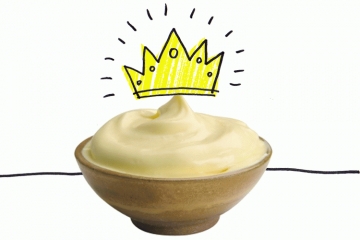Ingredients
- 1 large egg yolk
- 1 teaspoon salt
- 1/4 teaspoon Dijon mustard
- 1 tablespoon lemon juice (or combination of lemon and vinegar)
- 3/4 cup oil
- Special equipment: A blender or food processor are great, but a whisk and bowl work just fine. Put your oil in a pourable measuring cup, or something that lets you control how fast you pour.
Directions
- Combine the salt, yolk, mustard and about half the lemon juice and whisk together. The salt will help to break the yolk down into a thick liquid, which makes for more thorough emulsions. (Keeping the yolk mixture thick at the start is why I recommend saving half the lemon until later.) Whisk for about 30 seconds (or buzz in your machine), until the mixture is bright-colored and thick.
- If your bowl has a tendency to slide, put a towel under it, or roll a towel up lengthwise into a “rope,” and wrap it around the bottom of the bowl for stability. Whisk (or buzz) away, slowly drizzling in the oil. The point here is to start the emulsification process; add too much oil at once and the oil droplets will have too many like-minded friends to cling to. Like a psychopath, you want to isolate the oil droplets in the yolk mixture so they have no one to turn to. I can’t believe I just said that.
- After you’ve used about 1/4 of the oil, pause and take a good look. Is the emulsion sticking? Is it opaque and thickening with no oil floating at top? It’s working! Yes! Whisk or buzz in the rest of the lemon juice, and continue slowly streaming in the oil. At this point, you can pour the oil in a little faster. But still whisk just as vigorously, and don’t go too crazy with the oil. If at any point you see oil start to pool at top, stop pouring and really work at it until the pool is emulsified in. Patience is key here; this is where most people break their mayo. They get cocky and start just dumping in oil. Be calm. It won’t take long. Meditate.
- When all the oil is in and the mayo still stands, congratulations! Give it a taste; again, flavor is the next challenge. Balance, adjust with salt or lemon or more oil. Check the thickness; it’s your preference, but to my mind, it should be stiff enough to hold soft peaks, but not much more. If it’s thin, whisk in more oil. Remember: Oil will thicken the mayo. If it’s too thick, add a little water or lemon, but just a little. You’d be surprised at how much even a little lemon (or water) will thin it out — it gets in between all the oil drops, and makes it “slip.” So add it in ¼ teaspoon increments or so.
Fixing a broken mayonnaise
- If there’s a lot of oil sitting at the top, pour it off back into your oil container. Did you use enough lemon/vinegar/water? If not, add a little. Try to whisk what’s in your bowl back together, or transfer it to a blender or food processor and let the machine go at it. If it comes back together, slowly drizzle your oil in and continue.
- If it doesn’t come back together, use more magic: In a clean bowl, get a fresh egg yolk, a pinch of salt, and a little water whisking. When it’s thick and bright, whisk or blend your broken mayo to it, and watch the emulsion come together. Now slowly add the poured-off oil and whatever left over that you didn’t use the first time, and taste and adjust. And if that doesn’t work, well, I’ll let you in on a secret. There is no mayonnaise better than Hellman’s anyway.

